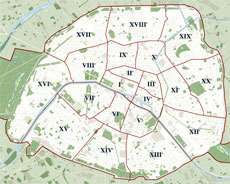Rue Mouffetard
|
Street markets such as this one in Rue Mouffetard are still common in France. Resellers and farmers sell fruits and vegetables, but also meat and fish, and other products. | |
 | |
| Length | 605 m (1,985 ft) |
|---|---|
| Width | 7 m (23 ft) |
| Arrondissement | 5th |
| Quarter | Saint-Victor . Jardin des Plantes . Val de Grâce . Sorbonne . |
| From | 3 rue Thouin |
| To | rue Censier and 2 rue Pascal |
| Construction | |
| Completion | c. 1st century |
Rue Mouffetard (French pronunciation: [ry muf.taʁ]) is a street in the 5th arrondissement of Paris, France.
Situated in the fifth (cinquième) arrondissement of Paris, Rue Mouffetard is one of Paris's oldest and liveliest neighbourhoods. These days the area has many restaurants, shops, and cafés, and a regular open market. It is centered on the Place de la Contrescarpe, at the junction of the rue Mouffetard and the rue de Lacepede. Its southern terminus is at the Square Saint-Médard where there is a permanent open-air market. At its northern terminus, it becomes the rue Descartes at the crossing of the rue Thouin. It is closed to normal motor traffic much of the week, and is predominantly a pedestrian avenue.
Origin of the name
The rue Mouffetard runs along a flank of the mont Sainte-Geneviève hill that was called "mont Cétarius" or "mont Cetardus" from Roman times; many historians consider "Mouffetard" to be a derivation of this early name. Over the centuries the rue Mouffetard has appeared as rue Montfétard, Maufetard, Mofetard, Moufetard, Mouflard, Moufetard, Moftard, Mostard, and also rue Saint-Marcel, rue du Faubourg Saint-Marceau ("street of the suburb Saint-Marceau") and rue de la Vieille Ville Saint-Marcel ("street of the Old Village Saint-Marcel").
History
The origins of this thoroughfare are ancient, dating back to Neolithic times. As with today's rue Galande, rue Lagrange, rue de la Montagne Sainte-Geneviève and rue Descartes, it was a Roman road running from the Roman Rive Gauche city south to Italy.
From the Middle Ages a church along this section of roadway became centre of a "bourg Saint-Médard" (Saint-Médard village), and from 1724 was integrated into Paris as the main artery of the "Faubourg Saint Médard".
The Diderot family moved at #6 rue Mouffetard in April 1746, where lived also François-Jacques Guillotte, a police officer who wrote an article (Pont militaire) for the Encyclopédie by Diderot.
The area remained relatively unchanged because of its location on the Montagne Sainte-Geneviève, which protected it from Baron Haussmann's redevelopment during the reign of Napoleon III.
Cultural references
In 1910 Alexander Bogdanov delivered a lecture about Empiriomonism. Lenin replied quoting his own Materialism and Empiriocriticism in response.[1] At the beginning of Chapter IV of The Sun Also Rises (1926), Ernest Hemingway describes a taxicab heading down the Rue Mouffetard from the Place Contrescarpe. The area and the street featured prominently in Krzysztof Kieślowski's Trois Couleurs: Bleu (1992).
References
- ↑ Biggart, John; Gloveli, Georgii; Yassour, Avraham (1998). Bogdanov and his Work. Aldershot: Ashgate. p. 233.
- Hillairet, Jacques (April 22, 2005). Connaissance du Vieux Paris. Rivages. ISBN 2-86930-648-2.
| Wikimedia Commons has media related to Rue Mouffetard. |
Coordinates: 48°50′31″N 2°20′59″E / 48.84194°N 2.34972°E
